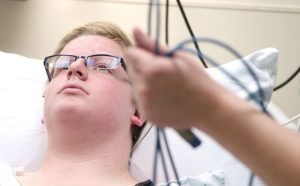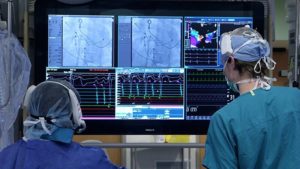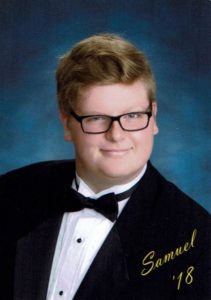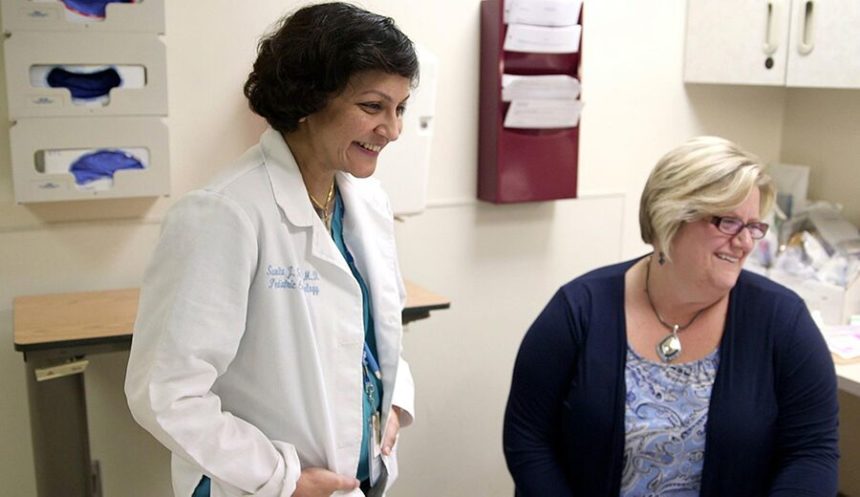When he was 14, Sam Deacon came to UNC with a very serious type of heart arrhythmia that had never been documented in medical journals. His condition was both rare and life-threatening, and his pediatric electrophysiologist, Sunita Ferns, MD, found herself facing the most challenging case of her career.
In 2014, during a visit to Sam’s pediatrician’s office in the family’s hometown of Wilmington, North Carolina, a nurse practitioner examining Sam for a suspected case of bronchitis noticed pulsing in his neck and discovered that Sam’s heart rate was nearly twice as fast as it should be.
Sam’s pediatrician referred him to UNC Children’s cardiology practice in Wilmington. Testing revealed that Sam had supraventricular tachycardia (SVT), a condition that stems from improper electrical activity in the heart and presents as a rapid heartbeat. From there, Sam was referred to Dr. Ferns, who directs the invasive electrophysiology program with UNC Children’s.
Dr. Ferns knew this was a serious condition when she met Sam.

“This is like running a marathon for your entire life through the day and night,” Dr. Ferns says of SVT, “and with time, it begins to take a toll, and you develop heart failure.”
Here’s how SVT happens: The heart’s electrical system controls the timing of the heartbeat by sending an electrical signal through the heart, enabling the chambers to contract and pump blood. In a healthy heart, the electric signals allow the chambers to contract in a smooth, orderly fashion.
Someone with SVT experiences an intermittent increased heart rate due to an abnormal electrical impulse. In Sam’s case, he had a very unusual form of SVT in which his heart rate was increased almost all the time. Additionally, the trigger for the abnormal electrical impulse was occurring on top of the tissue that normally controls the regular electrical impulses of the heart.
“It was in an extremely unusual location,” Dr. Ferns says. “They are usually in a location that’s far away from the normal conduction system, so they can be taken care of easily.”
Resolving the arrhythmia without damaging the normal tissue around Sam’s heart would be tricky, if it was possible at all. With no effective pharmaceutical options, Dr. Ferns faced a dilemma: attempt to address the arrhythmia surgically, by attempting to destroy the abnormal tissue with catheter-directed heating (a procedure known as radiofrequency ablation), which could likely require Sam’s use of a pacemaker, or leave the condition alone, which would ultimately be fatal.
To complicate matters even further, the pediatric cardiology team couldn’t find a single case like Sam’s anywhere in the medical literature. Dr. Ferns and her team were in uncharted territory performing the surgery, but it seemed to be the only option if they were going to save Sam from heart failure.

On December 12, 2014, Sam had his surgery at UNC Hospitals. Using state-of-the-art equipment that measures heart tissue down to a tenth of a millimeter, Dr. Ferns and her team went to work on his arrhythmia.
“In Sam’s case, I knew there was such a high risk of heart block, I was trying my best not to go off-path,” Dr. Ferns says. Heart block occurs when normal electric tissue is damaged and results in needing a permanent pacemaker.
Following what Dr. Ferns described as a “touch-and-go procedure,” she felt the case was a success, but only time would tell if the tissue was permanently destroyed or if it would regenerate and cause the SVT to recur.

At his doctor’s visit four weeks after the surgery, Sam got the good news—his surgery was a success.
Susan Jarvis, Sam’s mom, says she’s amazed at how much stamina he has now that his heart function is normal. Today, Sam is 18 and thinking about a career in health care. He recently graduated from his school’s early college program and will begin classes in the fall at Cape Fear Community College in Wilmington.
“Not only did Dr. Ferns save his life, she inspired him to want to make a difference in the lives of others,” Susan says.
Learn more about UNC Children’s services.

